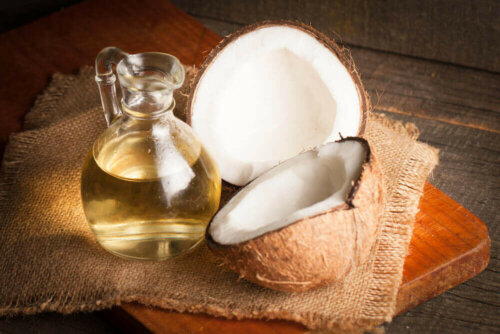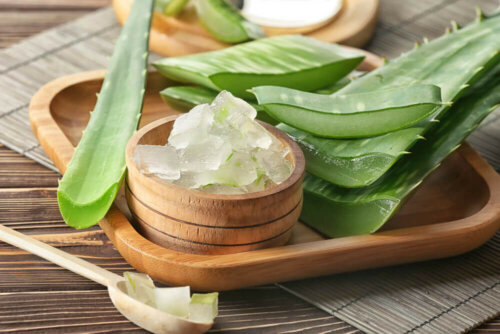Five Home Remedies for Hair Follicle Infection


Written and verified by the doctor Karla Henríquez
Hair follicle infection, also known as folliculitis, is a condition caused by the spread of germs. And, it’s almost always caused by the Staphylococcus variety. Also, hair follicles are found naturally on your skin. But pathogens can affect them if they receive certain stimuli from external agents.
This usually happens after shaving or using harsh methods of hair removal. However, it’s also associated with wearing tight clothing, poor hygiene, and obesity.
While it’s not a serious health issue, hair follicle infection can cause irritation, itching, and ingrown hairs that sometimes fill with pus. They tend to form on areas like the glutes, underarms, and neck since these are areas that are subject to frequent friction.
According to experts at the Mayo Clinic, to properly treat folliculitis, it’s necessary to see a doctor. Furthermore, depending on the case, they may prescribe some form of medication (creams or pills to control the infection, shampoos, pills to fight fungal infections, and creams or pills to reduce inflammation).
Five remedies to treat a hair follicle infection
These are 5 remedies that can help you treat a hair follicle infection since they help eliminate bacteria and, at the same time, reduce inflammation.
1. Use turmeric and coconut oil to treat a hair follicle infection

Combining turmeric with coconut oil gives you an antibacterial, exfoliating remedy. Additionally, it can help with folliculitis caused by bacteria.
It removes dead skin cells that are blocking your pores, and since it reduces inflammation, it minimizes the pain and itching.
Ingredients
- 1 tsp. of powdered turmeric
- 1 tbsp. of organic coconut oil
Preparation
- Add the ingredients to a container and mix until a thick paste is formed
How to apply
- Firstly, smooth the treatment over the areas affected by folliculitis and leave it on for up to 2 hours
- Then, when thoroughly dry, rinse with warm water and make gentle massaging motions to stimulate your circulation
- Finally, repeat every day until the hair follicle infection is under control
Read about The Eight Benefits of Turmeric That You’ll Want To Know
2. Tea tree and olive oil
Olive oil along with the special properties of tea tree oil makes an antiseptic and antibacterial solution. Furthermore, it has the ability to help with hair follicle infections.
Ingredients
- 3 tbsp. of olive oil
- 1/2 tsp. of tea tree essential oil
Preparation
- Combine the two oils
How to apply
- Firstly, smooth the oil over the affected areas and let it sit without rinsing
- Use every day until the folliculitis has improved
3. Oregano and coconut oil

Oregano essential oil is an antibacterial and antifungal remedy that can be applied topically to help speed up the healing process of folliculitis and other infections.
Its anti-inflammatory compounds help with the bumps caused by this condition. In addition, it’ll also help remove any ingrown hairs.
Ingredients
- 1 tsp. of oregano essential oil
- 2 tbsp. of coconut oil
Preparation
- Add the oils to a container and mix well
How to apply
- Firstly, massage the oil onto the affected areas for 5 to 8 minutes
- Then, let it sit without rinsing and use it every day
4. Apple cider vinegar
Although there’s no scientific evidence, the natural acids in apple cider vinegar are said to give it antibacterial and anti-inflammatory properties, which are ideal for folliculitis.
They help fight the bacteria that are causing the hair follicle infection. They also get rid of dead skin cells and contaminants in the follicle.
Ingredients
- 5 tbsp. of apple cider vinegar
- 1/4 c. of warm water
Preparation
- Dilute the apple cider vinegar with the water
How to apply
- Firstly, spray the liquid over the affected areas and let it absorb without rinsing
- Repeat 2 or 3 times a day until the hair follicle infection goes away
Get ready to Say Goodbye to Ingrown Hairs
5. Aloe vera and rose oil

The gel found in aloe vera leaves can be combined with a bit of rose oil to make an anti-inflammatory moisturizing cream that’s perfect for your skin if you have folliculitis.
Ingredients
- 2 tbsp. of aloe vera gel
- 1 tbsp. of rose oil
Preparation
- Combine the aloe vera gel with the rose essential oil until well-mixed
How to apply
- Firstly, apply the product to the irritated skin and let it sit for up to 2 hours
- Then, rinse with warm water and repeat every day
So, as you can see, there are many ways to disinfect and protect your skin if you ever get this kind of infection.
In case you wish to apply any of them, remember to consult your doctor first to avoid adverse reactions.
All cited sources were thoroughly reviewed by our team to ensure their quality, reliability, currency, and validity. The bibliography of this article was considered reliable and of academic or scientific accuracy.
- Epstein, F. H., Paus, R., & Cotsarelis, G. (1999). The Biology of Hair Follicles. New England Journal of Medicine. https://doi.org/10.1056/NEJM199908123410706
- Schneider, M. R., Schmidt-Ullrich, R., & Paus, R. (2009). The Hair Follicle as a Dynamic Miniorgan. Current Biology. https://doi.org/10.1016/j.cub.2008.12.005
- Canapi, E., Agustin, Y., Moro, E., Pedrosa, E. J., & Bendano, M. L. (2009). Coconut Oil. In Bailey’s Industrial Oil and Fat Products. https://doi.org/http://dx.doi.org/10.1071/SR99116
- Zorofchian Moghadamtousi, S., Abdul Kadir, H., Hassandarvish, P., Tajik, H., Abubakar, S., & Zandi, K. (2014). A review on antibacterial, antiviral, and antifungal activity of curcumin. BioMed Research International. https://doi.org/10.1155/2014/186864
- Murbach Teles Andrade, B. F., Nunes Barbosa, L., Da Silva Probst, I., & Fernandes Júnior, A. (2014). Antimicrobial activity of essential oils. Journal of Essential Oil Research. https://doi.org/10.1080/10412905.2013.860409
- MAKINO, S., CHEUN, H., TABUCHI, H., & SHIRAHATA, T. (2000). Antibacterial Activity of Chaff Vinegar and Its Practical Application. Journal of Veterinary Medical Science. https://doi.org/10.1292/jvms.62.893
- Nejatzadeh-Barandozi, F. (2013). Antibacterial activities and antioxidant capacity of Aloe vera. Organic and Medicinal Chemistry Letters. https://doi.org/10.1186/2191-2858-3-5
This text is provided for informational purposes only and does not replace consultation with a professional. If in doubt, consult your specialist.








